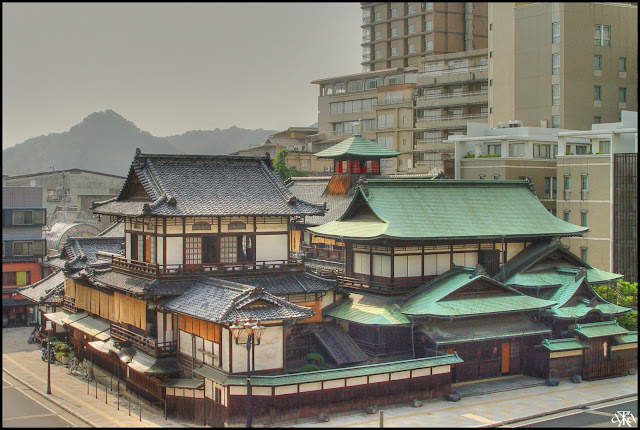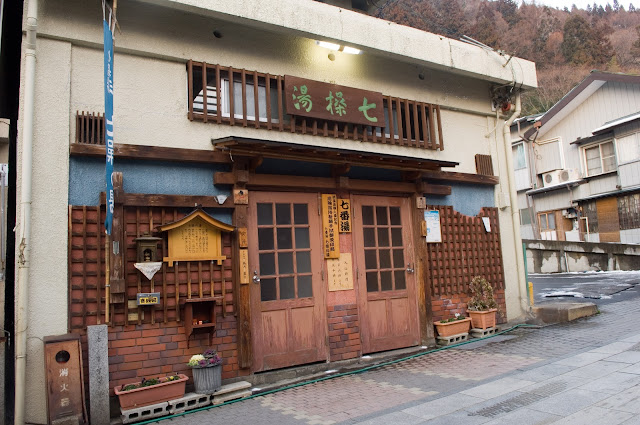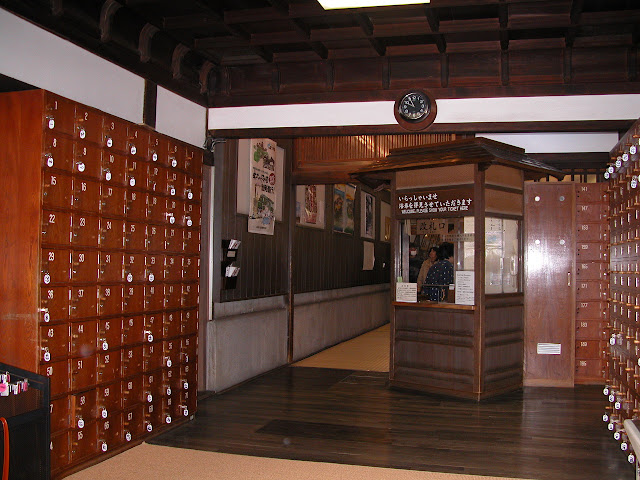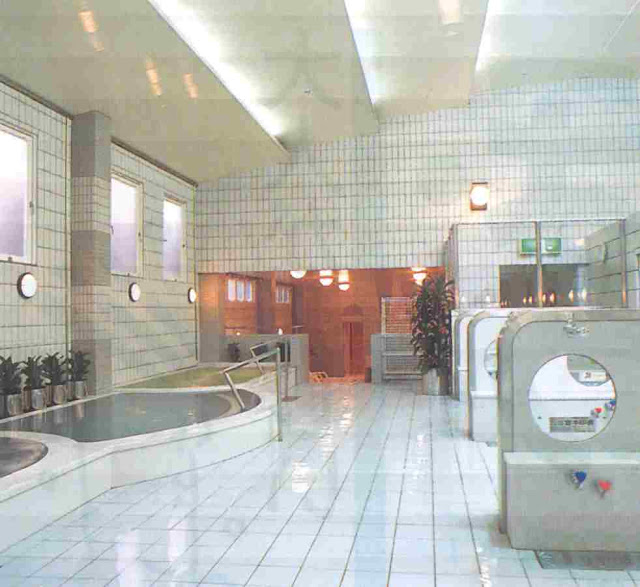Category Archives: 06 TT 047 Japanese bathing
Japanese overseas: the bathroom
Recently we were asked about the possibilities of having a Japanese home-stay and it brought back memories of Japanese exchange students and visitors settling into a new environment. Many people have had great exchange experiences – some have had unpleasant ones – but there seems to be a need for more precise information for these exchange students to help the visit go smoother. We will build up a section of pages giving information about exchange settling-in situations.
There is a big difference between a Japanese bathroom and a non-Japanese bathroom: the Japanese bathroom is water-proofed and it has a large built-in drain. Non-Japanese bathrooms often do not have drains in the floor boards outside the tub. This is a gigantic difference.
We remember the happy Japanese bather throwing buckets of water all over himself, while the hosts were downstairs waiting for him to come to dinner… The leaking downstairs ceiling, the wet carpet in the corridor as well as water down the stairs led to some frustration and quite some expense…
We remember the happy Japanese bather throwing buckets of water all over himself, while the hosts were downstairs waiting for him to come to dinner… The leaking downstairs ceiling, the wet carpet in the corridor as well as water down the stairs led to some frustration and quite some expense…
Another more common error is that hot water appears to be in seemingly endless supply in Japan, while in other countries hot water may come from a hot water cylinder or tank. One visitor’s bath may leave the rest of the family without hot water for the evening… and a power bill. Please, just show your visitor where the hot water cylinder is and explain in simple English the limitations of the situation. Your student will “get” the idea. It may be a shock though for them to discover that water and electricity are limited elsewhere in the world. Enough said.
Often in Japan the hand basin is outside the Japanese bathroom – close but separate.
Your visiting Japanese female student will turn up with her hairdryer and her one-tonne-weighing suitcase thinking she is travelling lightly. She will imagine that Australasian power points are the same as American ones, so you will need to show her. The power strength is similar to European power supplies, except that the plugs are very different. Most shops sell adapters. By the way, Asian hair is very thick, so it takes a long time to blow-dry your student’s hair and she doesn’t want to look “damp” – watch your power bill!
We don’t remember seeing a heater in a bathroom in Japan, nor did we see power-points. However, anything electric there was built-in and sealed off on account of short-circuiting. They did have a bathtub warming system and even a pump system for recycling hot water. More about the Japanese bath later.
Mind you, our bathroom power-points are all individually switched and fused.
We could write a book about electricity usage by Japanese in general. Unbelievable! Someone once compared Japan with “The land where the sun never sets”, because there seems to be no darkness in Japan. Never mind. Another day; another page.
Many Japanese homes have electronically-operated toilets with electronic flushing, bidet facilities and even built-in lights. Your Japanese visitors may feel they have plummeted into the last century, so be gentle with them. Mind you, not every toilet is like that. There are also ‘older-style toilets…’
Usually the Japanese toilet cistern is modeled on a hand wash basin, so fresh water flows into the basin and will become the grey water for the next flush. You may have to explain that you have a separate hand basin.
Because of the change in diet when moving to a western country, Japanese youngsters tend to put on some weight. It happens. As there are not so many stairs and the pace of living is slower, those pounds tend to linger. Invariably these deposits disappear once your student returns to Japan again.
.
In the last few years taps in older homes have been replaced and now the mixer tap is more common. What is important is that the Japanese language has two different words for hot water and for cold water. Hot water is in the bath, the jug and your tea and cold water is in the sea, the river and in your glass during dinner.
Towel rails tend to be electric these days.
But no, there is more!
The most important item in any bathroom:
These are about all the items one could find in a bathroom. We’ll give bathing a separate page. Again, be prepared for Japanese people leaving the lights on all over the place – even when they go to sleep! They tend to have no idea about electricity and the costs, and they use hot water as if it comes from the sun!
.
Matsuyama Public Bath, Shikoku
Kitchen Bathroom Laundry Garden
Public bath 銭湯 せんとう
Onsen 温泉 おんせん Hotpools
One famous onsen spa high up in the mountains.
The topic of ‘onsen’ is one of some confusion, a lot of interest and quite a lot of misunderstanding. We will try to explain the situation and then you can make up your own mind.
Japan is a volcanic country with a lot of geothermal activity. “In the olden” days villages would have access to an outdoor hot pool and the villagers would make the most of the bathing potential. Hygiene makes you live longer, so to say. As villagers had lived in the same place for many generations and grown up together, the idea of communal bathing was no surprise and certainly wouldn’t have been something unusual.
Many villages in the mountains were surrounded by the most awesome scenery either in summer, or when the mountains were covered with snow in winter. The community looked after the hot pools and it was readily available for everyone. Much, much later in history, when villages became towns and cities, did the local community begin to impose new rules in order to accommodate outsiders, who might be intruding, but who also might bring cash to the place – a useful commodity.
Some towns opted for segregation, others opted for strict supervision, others would opt for separate baths, if there was enough water available to make such decisions. High up in the mountains, where water was at a premium, it wasn’t always possible to segregate as many visitors wouldn’t really come, or they came as house guests of locals and then separating might be a cultural offence. Whatever the situation or the location, or the reason, baths evolved.
But then the “tourist yen” arrived. Lots of yen! An awful lot of yen! Hotels were built, town councils got involved. Hotels organised tourist trips to their own wonderful onsen baths. Locals could afford to have their own private baths at home, so the need for the outdoor public bath was no longer there.
With hotels more strangers arrived. New customs were developed. Modesty rules were imposed. Segregated times were enforced etc.
This town has a lot of geothermal activity, which it advertises, so that tourists come and stay in the hotels that have their own geothermal swimming pools.
Something to be recommended to any visitor to Japan: enjoy an onsen!
Either he loves nature, or he is communicating with nature. Never mind.
Entrance to an onsen pool complex, probably attached to a hotel.
These two so-called ‘noren’, on the left display ‘female’ and on the right ‘male’.
When westerners come to a Japanese onsen they need to adjust to the country, the culture and the situation. It also depends on the age of the visitor. Older, more mature people, or little children, easily fit into the expectations. The strategically placed modesty towel covers a lot.
Usually teenagers give the most trouble, as their own fantasies and insecurities are sprawled all over the entrance. This is a good opportunity to point out that beach wear these days in the western world is often less than flimsy. Somehow the modesty towel is suddenly too little. Utter nonsense. If you have such a teenager to deal with, leave them in the hotel, or send them shopping, or give them a DVD, or iPod or something. Don’t bother with an onsen.
By the way: NEVER wash yourself in the onsen! You only soak in the water. Washing is done earlier and later in the hotel bathroom. Think of it as an outdoor hot swimming pool.
As you can see, this onsen is completely man-made and probably an outdoor architect charged for the display to make the stones look as naturally set as possible.
This onsen even has a modest Roman character. Never mind.
Actually the winter is the best time of the year. As this photo shows, the combination of snow, cold, hot water, outside is amazing!
猿 さる saru monkey (macaque monkey)
And than the monkeys came. There are no millions of monkeys all over Japan ready to hop into a spa pool. Nonsense. One monkey (possibly Mrs Monk – joke) copied human behaviour and took her own baby monkey into the water and discovered the hot water. This was in the province Nagano. Where there is one monkey, there are more.
In that part of Nagano the monkeys have learnt to enter the onsen when humans are not there. The relationship between humans and monkeys is one of respect from a distance. The photo below was taken in a very particular onsen, mid-winter, so the monkey was freezing cold and would have liked to enter the water, but obviously wouldn’t.
When humans come, monkeys retreat. It’s the pecking order. By the way, don’t worry: monkeys are extremely clean.










































































































